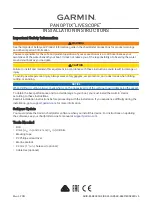
This mode allows for a single
OPS300
to seamlessly switch and blend any of its 12 analog/digital inputs with
any other of the inputs, add PIP, titling or logo insertion to the live frame, while previewing your every move
before going live, to avoid embarrassing errors on your main screen. The Mixer mode is the
OPS300
native
mode, and with no less than 6 layers (of which 3 live layers). The
OPS300
with the Video output allows to
have a full Main screen for recording or broadcasting.
This mode turns your
OPS300
into a true 12x2 scaled matrix, while preserving seamless switching capabilities.
Output #1 and #2 can be set to different resolutions and rates. Switching between any of the inputs can be
done with the various effects (Cut, Fade, Slides…) and synchronized on both outputs.
*
NOTE
* This mode leads the following restrictions: no PIPs, no logos and no frames.
INTRODUCTION
1-1. THE OPS300 OPERATING MODES
Before you start setting up your
OPS300
for the first time, be sure you know what you actually want to do with
it. The
OPS300
offers a choice of two operating modes, which results in a versatile video production tool for
live event staging and fixed installation applications.
* NOTE * :
We recommend resetting the device to its default values every time you set up your shows or
events (see the “
Operating The OPS300
” chapter, p25).
MIXER MODE
MATRIX MODE
4
Summary of Contents for ops300
Page 1: ...version 4 00 USER MANUAL Ops300...
Page 2: ......
Page 75: ...73 SOURCES EXAMPLE 2 DOUBLE SCREEN PRESENTATION USING OPS300 in Matrix Mode...
Page 79: ......







































